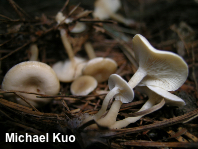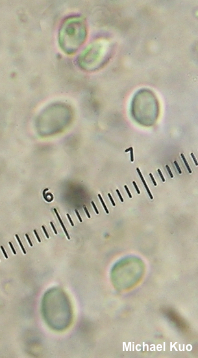| Major Groups > Gilled Mushrooms > Pale-Spored > Clitocyboid Mushrooms > Clitocybe subcanescens |

|
[Basidiomycota > Agaricales > Tricholomataceae > Clitocybe . . . ] Clitocybe subcanescens by Michael Kuo, 14 October 2022 I found the illustrated mushrooms in Wisconsin, under pines, on an island in the middle of the Wisconsin River. Tourist boats for the Wisconsin Dells floated by on the river, loaded with smiling white people who weren't quite sure if the half-Chinese man on his hands and knees in the woods was one of the featured attractions. He wasn't. Eighteen years later, after many revised identification decisions, I have decided the mushrooms represent Clitocybe subcanescens—a small, butterscotch-capped, conifer duff inhabiting clitocyboid mushroom described from Michigan and Idaho by H. E. Bigelow in the 1950s. According to Bigelow, distinguishing features for the species include its lack of a distinctive taste, the "canescence" (a thin whitish hoariness or pubescence) on its fresh cap, the fact that the edge of the cap does not become lined with age, and its small spores. Look-alike species include Clitocybe acerba (bitter taste, cap edge sometimes becoming lined, no canescence), Clitocybe flavidella (cap not canescent, becoming lined, pileipellis with yellow pigments under the microscope), Clitocybe glutiniceps (bitter taste, cap not canescent, becoming lined), and Clitocybe pinophila (mealy taste and odor, cap not canescent). Since all of these species are butterscotch-capped, small-spored conifer lovers, you will need a robust collection of fresh mushrooms, as well as time with a microscope, to attempt identification in this species group. Meanwhile, none of these species concepts have been subjected to contemporary, DNA-based analysis, to my knowledge. Description: Ecology: Saprobic; growing scattered or gregariously in needle duff under conifers; fall; originally described from Michigan and Idaho; possibly widely distributed in North America. The illustrated and described collection is from Wisconsin. Cap: 2–3 cm across; convex, becoming broadly convex with a shallow central depression; thin; moist; bald but with a thin whitish pubescence in places; butterscotch, fading to buff or whitish; hygrophanous; the margin not lined. Gills: Broadly attached to the stem or beginning to run down it; close; short-gills frequent; white. Stem: 1–3 cm long; 2–5 mm thick; more or less equal; moist; bald; becoming hollow; sometimes becoming flattened; pale yellowish to whitish; with white basal mycelium. Flesh: Thin; whitish. Odor and Taste: Not distinctive. Chemical Reactions: KOH negative on cap surface. Spore Print: White. Microscopic Details: Spores 3–5 x 2.5–3 µm; ellipsoid; with a tiny apiculus; smooth; hyaline in KOH; inamyloid. Basidia 22–24 x 3–4.5 µm; clavate; 4-sterigmate. Cystidia not found. Pileipellis a partially gelatinized cutis of elements 3–5 µm wide, smooth, hyaline in KOH; clamp connections present. REFERENCES: H. E. Bigelow, 1958. (Bigelow, 1982.) Herb. Kuo 09220403. This site contains no information about the edibility or toxicity of mushrooms. |
© MushroomExpert.Com |
|
Cite this page as: Kuo, M. (2022, October). Clitocybe subcanescens. Retrieved from the MushroomExpert.Com Web site: http://www.mushroomexpert.com/clitocybe_subcanescens.html |

